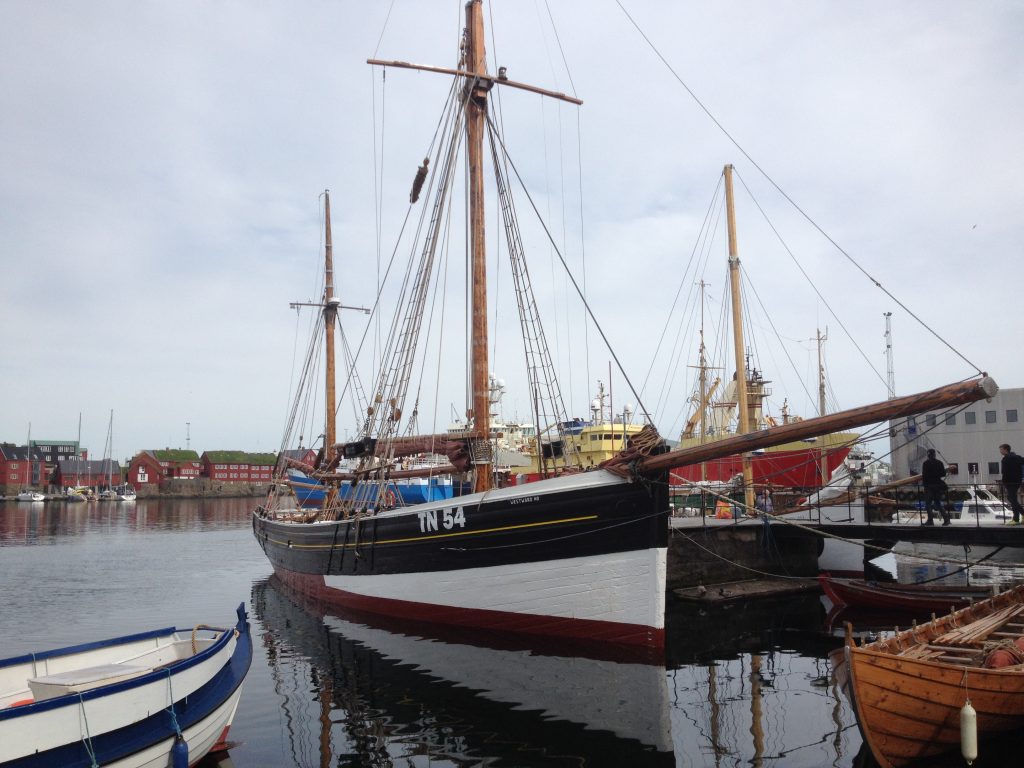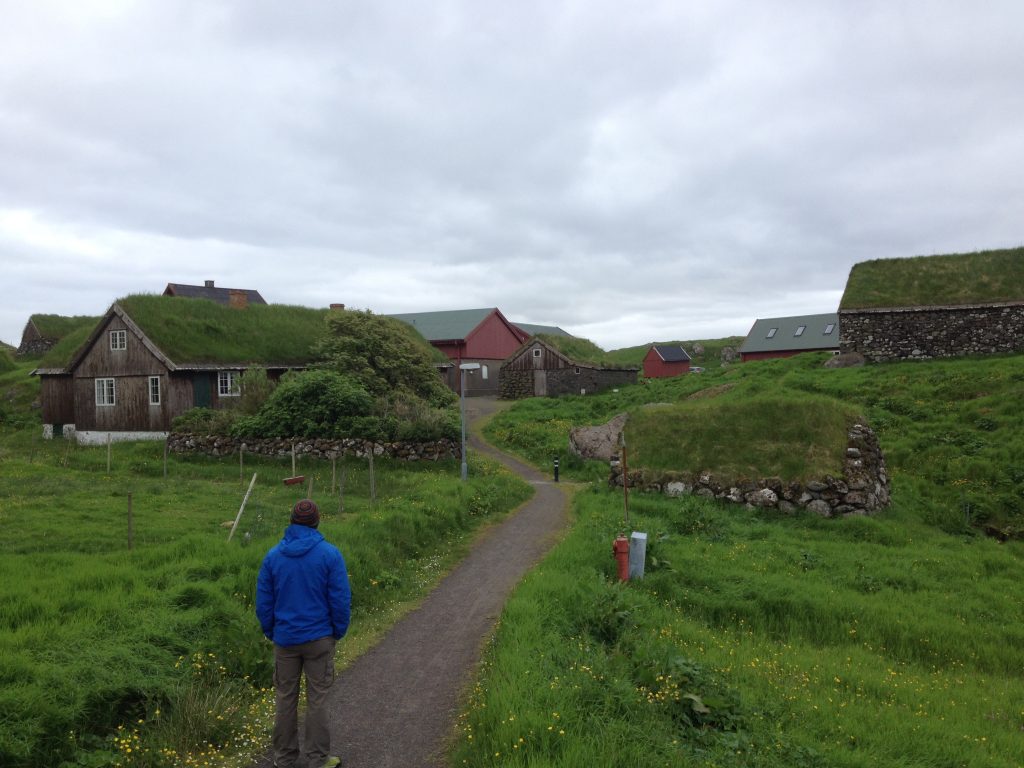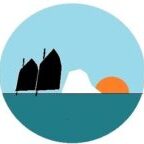LAKES, WATERFALLS AND THE CAPITAL (12 JUL 2015)
After a good night’s rest alongside in Miðvágur, we rose at a respectable time the following morning with a favourable forecast for the forenoon to walk out along the side of Lake Sørvagsvatn behind the town. The unusual thing about the lake is its proximity to the sea, and the fact that it empties over the sea cliffs via a rather impressive waterfall, Bøsdalafossur. It was a beautiful morning, and we had a pleasant walk along sometimes squidgy ground along the lake, diverting uphill to an impressive cleft in the sea cliffs where we could lie at the edge and get unimpeded views down to the sea, with Fulmar and Kittiwakes swooping below us. After the inevitable clifftop and rocky pinnacle photos, we headed down again to the waterfall, and by scrambling across the glacial debris and some impressive basalt pavement, we got down to the waterfall. It is neither the highest or most impressive one I have seen, but something about a lake emptying itself in to the sea makes this a stunning place.
After much rock hopping, we headed back to the boat, as we had carelessly omitted to take any food on the walk with us. After some sustenance and a change of clothes we headed back up the hill to the war museum. This had promised to be open between 1400 and 1700 on Saturday and Sunday, so we were eagerly waiting outside the door at 1400, with a small group of other tourists (the word “small” is pretty much superfluous here- there aren’t many tourists in the Faroes!); the doors did not open. We went next door into the Bonus Pig supermarket (actually just called Bonus, but with a pig as a logo) to buy chocolate, and when we came out, the tourists had gone and the door was still locked. We waited for another 15 minutes before we decided that it wasn’t opening for us, and went to find coffee and cake in “town” to console ourselves. It is a shame that the museum did not open, as by all accounts it is a good one, and was one of the reasons for coming to the otherwise unremarkable town.
Coffee and cake successfully consumed in a very warm coffee shop (which looked like it doubled as the town’s bar in the evenings), we headed back to the boat for the evening. By this time the wind had really picked up as was forecast, and I was glad that we had been allowed to berth alongside the fishing boat in her sheltered position, and not on the outer face of the quay, which would have been far more exposed to the easterly wind.
The wind had dropped off entirely by the morning, and we were able to depart as planned to head for the capital, Torshavn, with the tide. As I have already mentioned, working the tides here is essential, and whilst motoring all the way in very light airs, we experienced speeds over the ground of up to ten knots in between islands, and some wild waters off the SW corner of Streymoy. Once round the corner we then caught the back eddy on the western side of the channel between Streymoy and Nølsoy, so had to cross to get into the fair stream once more. Then came the fog. We leapt into blind nav mode again as the Suduroy ferry looked out of the murk. In the patchy conditions, I caught a glimpse of a large ship’s superstructure, which had me worried until the vis cleared sufficiently for me to verify that she was anchored. As is often the case, we felt our way into the approaches to Torshavn, whereupon the vis cleared enough for us to see our way in. As we were approaching the port, a pilot boat came out to board one of the Sea Shepherd protest ships, in the islands for the whale killing season. This tradition is perhaps the less acceptable face of the Faroes, which unfortunately gives the islands a bad name amongst some, but which is also the basis of much vitriol, which, whether justified or not, is frequently ill-informed. During the breeding season, Pilot Whales frequent the islands in their hundreds, or even thousands, and in the days when the Faroese subsisted very much on what meagre pickings they could from land and sea, a pod of whales approaching a village would initiate frantic activity. Rowing skiffs, which themselves were (and the indigenous boats still are) derived from the craft in which the Viking settlers first arrived, were launched and manned, and would herd the whales into the beach. The animals would be speared in the water and towed in, or driven into the beach itself, into the hands of men with knives who would slaughter them by severing the spine. Whales which drifted away or sank would be recovered later, and the creatures butchered leaving nothing to waste. Everyone who was involved in the kill would be entitled to a share of the meat, and it would be auctioned off by the local sheriff. The kills happen in very much the same way today, except that the boats are motorised, and one could argue that the need for the food is less. It is, however, a much cherished tradition, which is tightly controlled by the government. It has also become a target for the anti-whaling lobby, as the Faroes are one of the few remaining places in the world where whaling is still practiced legally. Sea Shepherd, a militant marine conservation organisation, which sometimes employs dubious methods verging on the criminal, has a ship in the islands and is monitoring the kills (we later saw a shore team who seemed to be more interested in watching their ship). Anyway, she was in the approaches to Torshavn as we arrived; slightly mysteriously, although she took a pilot, she did not come into the harbour.
We got in alongside at the capital’s well-established visitors’ berths, right in the town centre, and as we were securing, we were hailed from across the pontoon by our acquaintances from Tvøroyri, Philip and Lynda.
The afternoon was spent in exploring a little of what Torshavn has to offer. On a Sunday, it has to be said that this is very little, at least if one has the number one British past-time in mind. There are some very pretty areas around the harbour, particularly Tinganes, the former seat of the Ting, or parliament. The parliament itself may have moved into more modern accommodations, but some of the government’s departments, and the Prime Minister’s office, are still here, housed in red-painted, turf-roofed clapboard buildings perched on a rocky promontory. Also of interest around the harbour were two of the old “Slupps”, sailing fishing smacks bought in from the UK in the early 20th century as the fishing was industrialised. One, the Westward Ho!, was built in Grimsby and is beautifully kept as a sailing museum; the other, Nordlvsid, unusually schooner-rigged, berthed right astern of us, and does day trips for tourists.

In the evening we strove to find somewhere decent to eat for not too many Kroner. It would have been nice to try some of the local delicacies – although Puffins are no longer caught for food, it seems, and we saw no evidence of any seabirds in the shops, and trying pilot whale or its blubber might have been deemed politically incorrect (although there is a restaurant in Torshavn which has Pilot Whale on the menu, but it has the worst reviews I have ever seen on Trip Advisor, and the whale was deemed to have been “overcooked”), it would have been nice to dine on dried lamb or dried cod or something of that ilk. However, there is one restaurant in Torshavn which claims to cook local cuisine (or rather New Nordic), which is amusingly named Koks, and is out of the price range of the average gaff ketch owner. If you want pizza, burgers or even Sushi, you are well-catered for, but there is sadly a shortage of places offering simple, local nosh. In the end we plumped (perhaps not the most appropriate use of the word) for Barbara’s Fish House, where we had salt cod with two different (but not that different) sauces, potatoes and cabbage, which was actually very nice but not a huge meal. My advice if you are looking for a gastronomic experience, is not to expect one in the Faroes! (Editor’s Note – On a later visit to Torshavn in Lord Nelson in the summer of 2019, we found a good steakhouse right next to the ferry terminal)
Monday morning saw us visiting the (now open) supermarket to stock up on food essentials, and then go to do some sightseeing and go on a quest for the other essential, beer, which, like all alcoholic products, is strictly controlled and not sold in normal supermarkets.

We hopped on one of the free buses which ply a handful of routes around the town (although everywhere is pretty much walking distance for the reasonably fit), and headed out to Hoyvik, a suburb to the north of the city. There we found the very good National Museum and the attached Outdoor Museum, which is a former farmstead. We spent a good few hours looking around these, before walking back towards the city through a nice area of parkland cum pasture to find the beer shop. Our first stop was in another branch of Bonus Pig, which seemed to be staffed entirely by under-16s, and proved not to be the where we wanted to be looking. I accosted a very young- and very Nordic-looking blond lad wearing an “ask me anything” sweatshirt, who first looked worried when I asked if he spoke English (a silly question really), as if he thought I would ask him the meaning of life, but when he realised that all I wanted to know was where the shop that sells beer was situated, he looked relieved, grinned, and said “follow me”. He showed us out of the store and pointed out the shop next door, which very obviously contained shelves and shelves of wine and spirits, as well as slabs of beer in large stacks. We made our choice (Foroyar Classic dark lager) and returned home on the free bus.
In the evening we invited Philip and Lynda over for drinks, to reciprocate their invitation in Tvøroyri. After much chat, beer (hard won) and nibbles, they returned to their boat and left us to our dinner and a good night’s sleep prior to our departure and return to Scotland.
